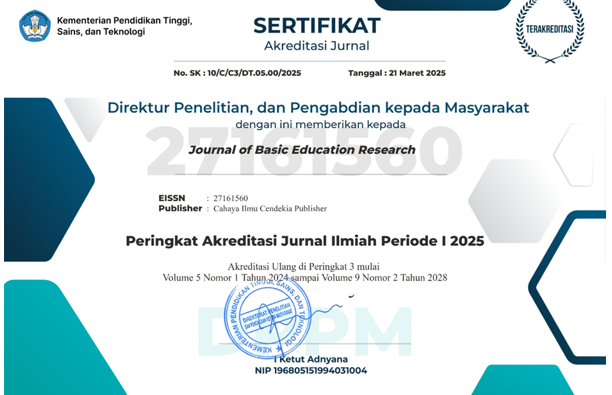Implementation of Reading Aloud Methods to Improve Early Reading Skills: A Case Study Analysis in Elementary School
Abstract
Purpose of the study: This study aims to examine the implementation of the reading aloud method to improve early reading skills among first-grade students at public alementary school 1 Talesan. The focus includes the instructional process, student responses, skill development, and challenges faced during the intervention.
Methodology: This research used a qualitative approach with a case study design. Data were collected using observation sheets, semi-structured interviews, and documentation analysis. The study involved one Grade I teacher and 19 students. Data were analyzed using Miles and Huberman’s interactive model, and data validation employed triangulation of sources and techniques.
Main Findings: The reading aloud method significantly improved students' prosodic reading skills, particularly intonation and vocal clarity. Students demonstrated increased participation and reading confidence. Challenges included varied reading proficiency levels and limited instructional time, which were mitigated through adaptive strategies such as visual aids and individual mentoring.
Novelty/Originality of this study: This study presents a contextualized model for implementing the reading aloud method in early-grade classrooms using socio-emotional scaffolding. The findings contribute new insights into integrating expressive reading with adaptive teaching to enhance early literacy in post-pandemic learning environments.
References
G. Baimakhanova, S. Baimakhan, and G. Boranbayeva, “Pedagogical approaches to developing the foundations of early literacy in first grade school students,” 3i intellect idea innovation - интеллект идея инновация, 2024, doi: 10.52269/22266070_2024_4_180.
C. Purwaningsih and A. Syamsudin, “Pengaruh perhatian orang tua, budaya sekolah, dan teman sebaya terhadap karakter religius anak,” Jurnal Obsesi: Jurnal Pendidikan Anak Usia Dini, vol. 6, no. 4, pp. 2439–2452, 2022.
J. D’agostino and E. Rodgers, “Literacy achievement trends at entry to first grade,” Educational Researcher, vol. 46, pp. 78–89, 2017, doi: 10.3102/0013189X17697274.
R. Razimona, S. Silvhiany, and M. Vianty, “Exploring english literacy learning at the first grade of elementary school,” IJELTAL (Indonesian Journal of English Language Teaching and Applied Linguistics), 2024, doi: 10.21093/ijeltal.v9i2.1781.
Y. Yenti, “An analysis of recount text comprehension at the eighth grade of SMPN 12 Jambi City,” Jurnal Ilmiah Universitas Batanghari Jambi, 2021, doi: 10.33087/JIUBJ.V21I2.1573.
S. Zuilkowski, D. McCoy, C. Jonason, and A. J. Dowd, “Relationships among home literacy behaviors, materials, socioeconomic status, and early literacy outcomes across 14 low- and middle-income countries,” Journal of Cross-Cultural Psychology, vol. 50, pp. 539–555, 2019, doi: 10.1177/0022022119837363.
M. Crawford, D. Rutkowski, and L. Rutkowski, “Improving reading abilities, attitudes and practices: A home-based intervention of supplementary texts for young readers in Cambodia,” International Journal of Educational Development, 2023, doi: 10.1016/j.ijedudev.2023.102906.
A. Kocaj, K. S. Cortina, A. F. Vereb, and J. F. Carlisle, “Exploring individual changes in disability status and their relations to reading comprehension development,” Remedial and Special Education, 2023, doi: 10.1177/07419325231217521.
R. Mattison, A. D. Woods, P. L. Morgan, G. Farkas, and M. Hillemeier, “Longitudinal trajectories of reading and mathematics achievement for students with learning disabilities,” Journal of Learning Disabilities, vol. 56, pp. 132–144, 2022, doi: 10.1177/00222194221085668.
E. Duursma, M. Augustyn, and B. Zuckerman, “Reading aloud to children: the evidence,” Archives of Disease in Childhood, vol. 93, pp. 554–557, 2008, doi: 10.1136/adc.2006.106336.
E. W. Rahayu and A. Mustadi, “The read-aloud method to develop reading literacy at school’s educational park,” Jurnal Prima Edukasia, 2022, doi: 10.21831/jpe.v10i2.47331.
M. Mascareño, M. Deunk, C. Snow, and R. Bosker, “Read-alouds in kindergarten classrooms: a moment-by-moment approach to analyzing teacher–child interactions,” European Early Childhood Education Research Journal, vol. 25, pp. 136–152, 2017, doi: 10.1080/1350293X.2016.1266226.
L. Slay and T. Morton, “Engaging pre-service teachers in read alouds,” Changing English, vol. 27, pp. 64–82, 2020, doi: 10.1080/1358684X.2019.1710696.
L. E. Slay and T. B. Morton, “Engaging pre-service teachers in read alouds,” Changing English, vol. 27, no. 1, pp. 64–82, Jan. 2020, doi: 10.1080/1358684X.2019.1710696.
R. E. Mattison, A. D. Woods, P. L. Morgan, G. Farkas, and M. M. Hillemeier, “Longitudinal trajectories of reading and mathematics achievement for students with learning disabilities,” J Learn Disabil, vol. 56, no. 2, pp. 132–144, Mar. 2023, doi: 10.1177/00222194221085668.
B. B. Sezer, F. Ç. Çetinkaya, D. K. Tosun, and K. Yıldırım, “A comparison of three read-aloud methods with children’s picture books in the Turkish language context: Just reading, performance based reading, and interactional reading,” Studies in Educational Evaluation, vol. 68, p. 100974, 2021, doi: 10.1016/J.STUEDUC.2020.100974.
I. Ismail, T. I. Rezeki, and A. Purba, “The effect of the reading aloud strategy on improving reading comprehension in binjai state high school students,” Journal of Ecohumanism, 2024, doi: 10.62754/joe.v3i4.3793.
N. D. Yuliani, S. Raudah, and H. Apriliani, “The effectiveness of reading aloud to improve students’ reading comprehension,” Nusantara Journal of Education and Social Science, 2024, doi: 10.69959/nujess.v1i1.15.
M. Cockerill, A. Thurston, and J. O’Keeffe, “Using fluency and comprehension instruction with struggling readers to improve student reading outcomes in english elementary schools,” International Journal of Educational Research Open, vol. 5, p. 100264, Dec. 2023, doi: 10.1016/j.ijedro.2023.100264.
W. Moussa and E. Koester, “Effectiveness of read-aloud instruction on reading and math outcomes : evidence from northern Nigeria,” 2018.
R. Thompson, “Cultural context in digital learning environments: A theoretical framework,” Computers & Education, vol. 189, 2023, doi: 10.1016/j.compedu.2023.104598.
J. Ruotsalainen, E. Pakarinen, A. Poikkeus, and M.-K. Lerkkanen, “Associations between students’ reading performance and literacy instruction in first grade: a cross-lagged study,” European Journal of Psychology of Education, 2023, doi: 10.1007/s10212-023-00784-4.
A. Kumar, “Conceptualizing ‘classroom teaching-learning process’ that engages students in Indian business school,” International Journal of Educational Management, vol. 36, no. 7, pp. 1238–1254, Oct. 2022, doi: 10.1108/IJEM-02-2022-0079.
R. McGee, S. Williams, T. Moffitt, and J. Anderson, “A comparison of 13-year-old boys with attention deficit and/or reading disorder on neuropsychological measures,” J Abnorm Child Psychol, vol. 17, no. 1, pp. 37–53, 1989, doi: 10.1007/BF00910769.
B. C. Davidson et al., “Universal teacher-child interaction training in early special education: a pilot cluster-randomized control trial,” Behavior Therapy, vol. 52, no. 2, pp. 379–393, Mar. 2021, doi: 10.1016/j.beth.2020.04.014.
Sugiyono, Quantitative, qualitative, and R&D research methods. Bandung: Alphabeta, 2017.
M. Gayoso Heredia, C. Sánchez-Guevara Sánchez, and F. J. Neila González, “Integrating lived experience: Qualitative methods for addressing energy poverty,” Renewable and Sustainable Energy Reviews, vol. 189, p. 113917, Jan. 2024, doi: 10.1016/j.rser.2023.113917.
Huberman & Saldana, Qualitative Data Analysis : A Methods Sourcebook. Inc: SAGE Publictions, 2014.
J. T. Kamila and A. Nanggala, “Penerapan kegiatan literasi dengan metode reading aloud untuk meningkatkan keterampilan membaca permulaan siswa kelas rendah (studi kasus pada kelas 1 SDN cinangka 03 kabupaten Bandung),” joe, vol. 6, no. 1, pp. 1970–1978, Jun. 2023, doi: 10.31004/joe.v6i1.3181.
H. B. Lane and T. L. Wright, “Maximizing the effectiveness of reading aloud,” The Reading Teacher, vol. 60, pp. 668–675, 2007, doi: 10.1598/RT.60.7.7.
C. M. Rumbaugh and J. Landau, “Recognition and recall performance both benefit from the production effect with content-specific information,” Reading Psychology, vol. 39, pp. 29–40, 2018, doi: 10.1080/02702711.2017.1361494.
K. A. J. Mohr, J. D. Downs, P. Chou, and H. Tsai, “Using read-alouds to teach inferencing from the start,” Early Childhood Educ J, vol. 51, no. 3, pp. 419–429, Mar. 2023, doi: 10.1007/s10643-022-01311-8.
E. Wahyuningsih, N. Suciyati, and D. F. Rahman, “Improving children’s reading motivation and skills through read aloud: A mixed-method study in orphanage context,” Jo-ELT (Journal of English Language Teaching) Fakultas Pendidikan Bahasa & Seni Prodi Pendidikan Bahasa Inggris IKIP, 2023, doi: 10.33394/jo-elt.v10i2.7902.
S. Ceyhan and M. Yıldız, “The effect of interactive reading aloud on student reading comprehension, reading motivation and reading fluency,” lnternational Electronic Journal of Elementary Education, 2021, doi: 10.26822/IEJEE.2021.201.
M. Steenberg et al., “Facilitating reading engagement in shared reading,” Poetics Today, vol. 42, pp. 229–251, 2021, doi: 10.1215/03335372-8883234.
Copyright (c) 2025 Srihandayani Ningsih, Retno Winarni, Rukayah Rukayah

This work is licensed under a Creative Commons Attribution 4.0 International License.
Authors who publish with this journal agree to the following terms:
- Authors retain copyright and acknowledge that the Journal of Basic Education Research is the first publisher licensed under a Creative Commons Attribution 4.0 International License.
- Authors are able to enter into separate, additional contractual arrangements for the non-exclusive distribution of the journal's published version of the work (e.g., post it to an institutional repository or publish it in a book), with an acknowledgment of its initial publication in this journal.
- Authors are permitted and encouraged to post their work online (e.g., in institutional repositories or on their website) prior to and during the submission process, as it can lead to productive exchanges and earlier and greater citation of published work.





.png)


.png)
.png)


















